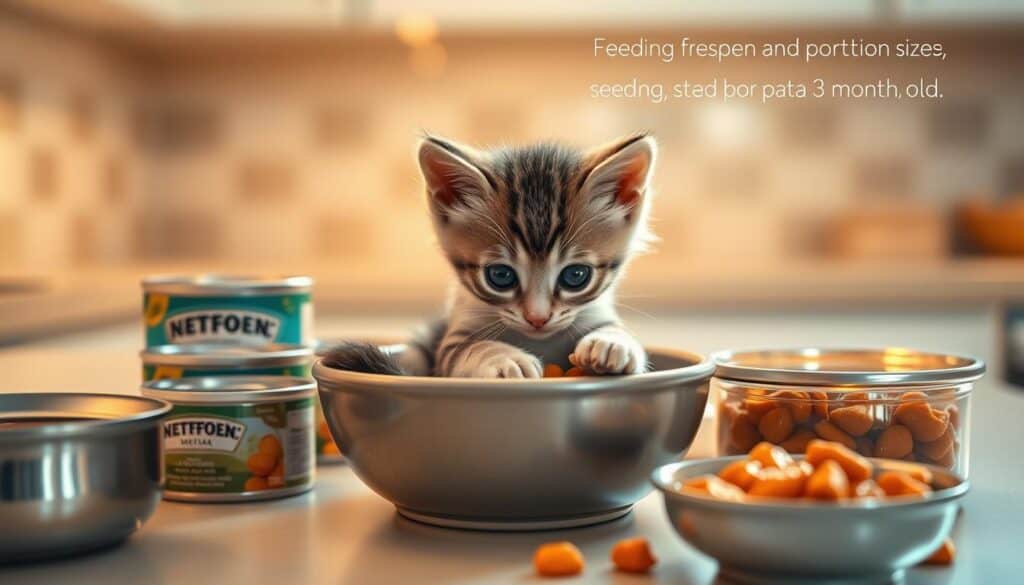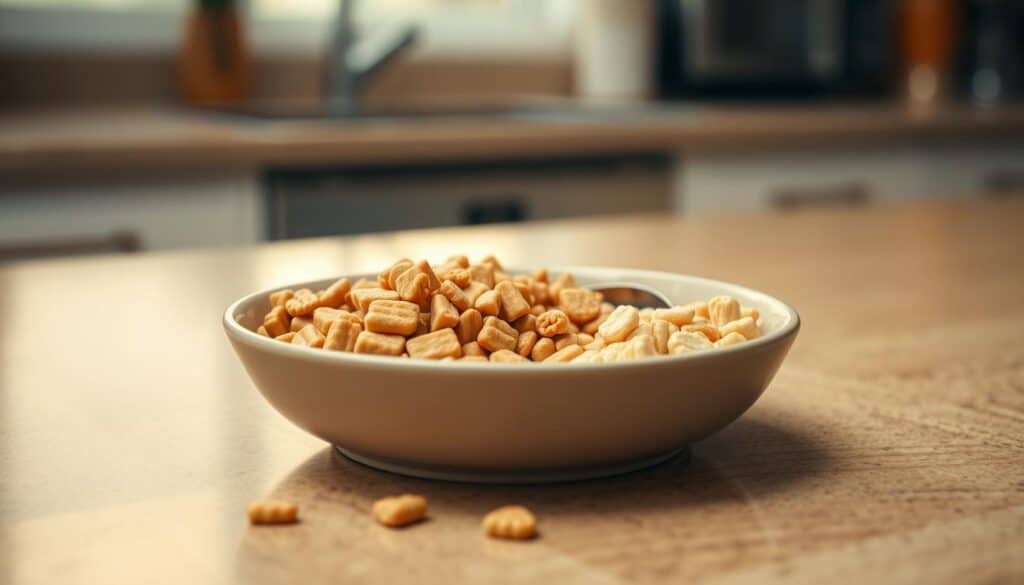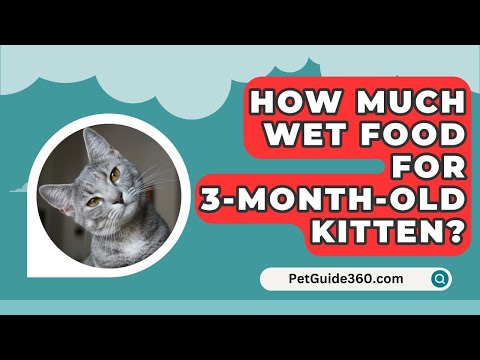Feeding kittens the right amount of wet food is key for their growth and health. Kittens at 3 months old are growing fast. They need the right nutrition to stay healthy.
This section will help you know how much wet food a 3-month-old kitten needs. It will guide you in setting up a good feeding routine. This routine will support their high energy levels.
Key Takeaways
- Proper wet food portions are vital for kitten health.
- Monitor growth to adjust feeding amounts.
- Feeding frequency matters for optimal nutrition.
- Choose a high-quality wet food for better health outcomes.
- Consult with a vet for personalized feeding advice.
Understanding the Nutritional Needs of Kittens
Proper kitten nutrition is key for healthy growth and development. At three months, kittens grow fast physically and mentally. It’s important to meet their nutritional needs for lifelong health and energy.
The Importance of Proper Nutrition
Nutrition is more than just food; it’s the base for a kitten’s well-being. A balanced diet builds strong bones and muscles. It also supports the nervous system and immune defenses. Without the right nutrients, kittens might face growth delays and health issues.
Key Nutrients for Growing Kittens
Essential nutrients for kittens include proteins, fats, vitamins, and minerals. High-quality protein is key for muscle growth. Fat gives the energy for play. Vitamins A, D, and E support vision and bone health.
Minerals like calcium and phosphorus are vital for bones and teeth. These elements together provide a nutritious base for kitten growth.
Choosing the Right Wet Food for Kittens
Choosing the right wet food is key for kittens’ growth. A balanced diet gives them the nutrients they need. Look at ingredient quality, nutritional labels, and packaging when picking.
What to Look for in Kitten Wet Food
High-quality kitten food should list real meat first. This is important for muscle growth. Stay away from artificial additives and fillers.
Choose foods with vitamins and minerals for health. The right food also helps with staying hydrated.
Brands That Cater to Kitten Nutrition
Many brands focus on kitten nutrition. Royal Canin offers formulas tailored for kittens. Blue Buffalo uses natural ingredients for health.
Hill’s Science Diet is known for its scientific formulas. These brands make choosing the right food easier.
how much wet food to feed a kitten 3 months
Knowing how much wet food to give a 3-month-old kitten is key for their health. Experts say to feed about 3 to 4 ounces of top-notch wet food each day. This can be split into several meals to help with digestion and keep their energy up.
Because kittens grow fast, it’s important to feed them the right amount. This ensures they get enough nutrients without eating too much.
Recommended Daily Portions
The right amount of food for a 3-month-old kitten depends on their weight and how active they are. A good starting point is 1 ounce of wet food per pound of body weight per day. For example, a 3-pound kitten would need about 3 ounces of food daily.
But, it’s important to adjust this based on your kitten’s specific needs. Your vet can offer valuable advice on how much to feed your kitten.
Factors That Influence Feeding Amounts
Several things can affect how much food a 3-month-old kitten needs. Their breed can influence their growth rate and calorie needs. Health issues might also mean they need a different diet.
Also, how hungry they are and how active they are can change their food needs. Always watch your kitten’s health and adjust their food as needed to keep them healthy and well-fed.
Feeding Frequency for 3-Month-Old Kittens
It’s important to know how often to feed kittens to help them grow and stay healthy. At three months, kittens do best with a set schedule that meets their needs. They need to eat often to keep their energy up and support their fast growth.
Knowing when your kitten is hungry is key. It helps you set up a feeding routine that works for both of you.
How Many Meals Per Day?
Three-month-old kittens usually need about four meals a day. This keeps their energy steady and supports their fast metabolism. Spacing out meals helps avoid hunger and keeps your kitten happy and active.
Feeding at regular times makes mealtime a routine. It’s good for your kitten and makes things easier for you too.
Signs of Hunger in Kittens
It’s important to know when your kitten is hungry. They might meow, paw at their bowl, or follow you to the kitchen. Paying attention to these signs helps you feed them on time.
This way, your kitten stays happy and healthy. Watching for these signs helps you adjust their diet and make sure they get what they need.

Adjusting Wet Food Portions as Kittens Grow
Kittens grow and their needs change. It’s important for owners to adjust their feeding plans. This isn’t just about following a schedule. It’s about making sure each kitten gets the right nutrients for growth.
Monitoring Growth and Weight
It’s key to check a kitten’s weight and growth often. A growth chart can help track progress. If a kitten’s weight and height keep going up, it means they’re getting enough food.
When to Increase Food Portions
There are signs that a kitten might need more food. If they gobble up their meals and look hungry, or if their growth slows down, it’s time to think about increasing their portions. Owners should watch their kittens closely and talk to a vet for advice on making these changes.
Common Mistakes in Feeding Kittens
Feeding kittens needs careful thought to help them grow well. Mistakes in feeding can happen, like giving too much or too little food. Knowing these mistakes helps owners care for their kittens better.
Overfeeding vs. Underfeeding
Feeding kittens too much can cause obesity and health problems. Too many calories from fatty foods can make them tired and act out. Not feeding enough can lead to malnutrition, slow growth, and weak immune systems. Finding the right balance is key for their health.
Ignoring Feeding Guides
Feeding guides tell you how much to feed based on a kitten’s age and weight. Not following these guides can lead to mistakes in feeding. Using these guides helps avoid overfeeding or underfeeding, ensuring kittens get the nutrients they need.
Benefits of Wet Food for Kittens
Choosing the right food is key for kittens’ growth and health. Wet food has many benefits that meet their nutritional needs. It’s not just tasty; it also helps with kitten hydration and health.
Hydration and Health
Keeping kittens hydrated is vital, and wet food helps a lot. It has more moisture than dry food, which is good for kittens. This helps their kidneys, digestion, and keeps their skin and fur healthy.
Wet food also boosts kittens’ energy and health during their growth. It’s a big part of their diet.
Palatability for Picky Eaters
Picky eaters can be tough for pet owners. But, many kitten foods are made to be tasty and appealing. Wet food smells and tastes better, making it perfect for fussy eaters.
The variety of flavors can make kittens want to eat more. This ensures they get the nutrients they need for growth. Using wet food can make mealtime easier for kittens and their owners.
Transitioning from Kitten Food to Adult Food
Kittens grow up and need to switch to adult cat food. This usually happens around one year old. But, it depends on the kitten’s growth and needs. Signs like more energy and weight changes mean it’s time for a change.
It’s important to follow adult cat food guidelines. This ensures they get the right nutrients during their growth.
When to Make the Switch
Deciding when to switch food depends on age and weight. Kittens around one year old are ready for adult food. Look for signs like slower growth or more hunger.
Regular vet visits can help figure out the best time. They ensure a healthy transition to adulthood.
How to Transition Smoothly
Transitioning food smoothly is key to avoid digestive problems. Start by mixing the new food with kitten food over seven to ten days. This helps the kitten get used to the new tastes and textures.
Small steps make the transition easier. It keeps the kitten’s health a top priority during this important time.

Keeping Kittens Healthy Through Proper Feeding
Keeping kittens healthy is key during their early months. Regular vet visits are essential to track their growth and health. These visits help spot any problems early, ensuring kittens get the care they need.
Watching how kittens eat is also vital. It shows if they’re doing well or need diet changes. Changes in appetite or food preferences can help owners make better food choices for their kittens.
FAQs on Feeding Kittens
Many pet owners have questions about feeding kittens. One big question is how much wet food a 3-month-old kitten needs. Kittens at this age need a diet rich in nutrients for their fast growth. They usually do well on about ¼ to ½ can of high-quality kitten wet food per meal, spread out over the day.
Another common question is how to tell if a kitten is eating enough. Signs include licking the bowl clean, being full of energy, and staying at a healthy weight. It’s important for owners to watch their kitten’s health and adjust food amounts as needed.
Some new kitten owners also ask when to switch to adult cat food. It’s best to make this change around 12 months of age. Adult cats need different nutrients than kittens. Gradually changing their food helps avoid stomach problems and makes the transition smoother.




